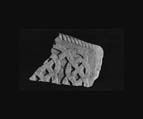Select a site alphabetically from the choices shown in the box below. Alternatively, browse sculptural examples using the Forward/Back buttons.
Chapters for this volume, along with copies of original in-text images, are available here.
Object type: Part of grave-cover
Measurements: H. 19 cm (7.5 in) W. 22 cm (8.5 in) D. 8 cm (3.25 in)
Stone type: [Uneven-grained oolitic limestone, with ferruginous inclusions and micritic layer chosen for the carved surface. Lincolnshire Limestone but not Ancaster or Barnack types]
Plate numbers in printed volume: Fig. 14; Ill. 350
Corpus volume reference: Vol 5 p. 255
(There may be more views or larger images available for this item. Click on the thumbnail image to view.)
A fragment from one end of a flat, rectangular or slightly tapering cover of Lindsey type, decorated in low relief and only on the upper surface.
A (top): The border is defined by a single cable moulding and the central panel is occupied by the remains of two interconnecting lines of simple pattern F interlace, which produce a repetitive figure-of-eight pattern in one surviving row. The figure-of-eight units measure approximately 12.75 × 8.75 cm (5 × 3.5 in): the layout and spacing is competently regular. The decoration stands sharply as a squared U section against the flat cut-away background.
B (long) and E (end): Broken.
C (end) and D (long): Undecorated, but worked into a curved or bowed section.
F (bottom): Broken.
This is part of an interlace cover of Lindsey type discussed in Chapter V. By virtue of its single cable border it belongs to sub-group (b) (Table 6). Its fine-quality stone and execution, too, resemble those of other Lindsey type covers. It differs from the norm principally in its small scale: if the full pattern was the normal three lines of interlace, its original width was only just about 36cm (14 in), easily the smallest of the surviving covers of this type. However, the small unit size most closely resembles that of Cumberworth 1 (Ill. 151), and on that model Stow 1 would allow reconstruction as part of a similarly hybrid cover with four lines of interlace divided into two fields by a longitudinal rib. In such a reconstruction, the cover would have measured approximately 48.5cm (19 in) wide, that is close to Cumberworth and to the norm for the type. Against this hypothesis, the fragment of Lindsey cover illustrated by Boutell (1854, 3; see Stow 2 below) was evidently of similarly small scale yet clearly of three or more undivided lines of interlace (Ill. 351). This piece therefore is likely to be from a similar small-scale monument.



